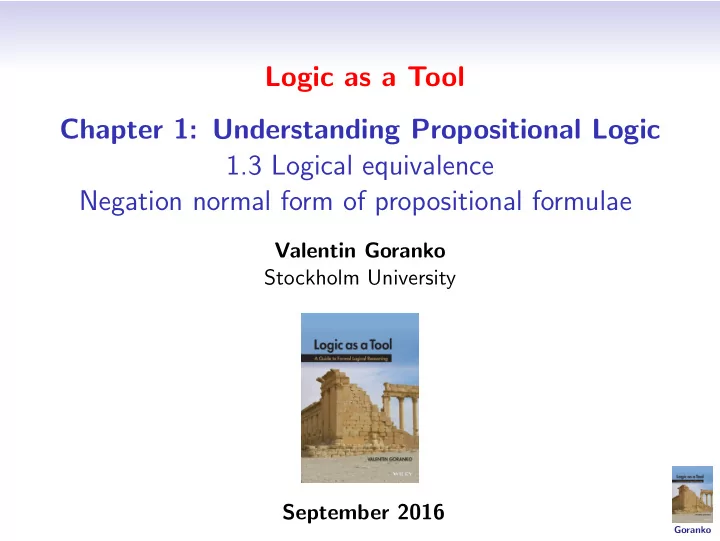

Logic as a Tool Chapter 1: Understanding Propositional Logic 1.3 Logical equivalence Negation normal form of propositional formulae Valentin Goranko Stockholm University September 2016 Goranko
Logical equivalence of propositional formulae Propositional formulae A and B are logically equivalent, denoted A ≡ B , if they obtain the same truth value under any truth valuation (of the variables occurring in them). Examples: ¬ ( p ∧ q ) ≡ ¬ p ∨ ¬ q ¬ ( p ∧ q ) ¬ ∨ ¬ p q p q T T F T T T F T F F T T F T T F F F T T T F F T T F F T T F T F T F F T F F F T F T T F p ∧ ( p ∨ q ) ≡ p ∧ p ≡ p p q p ∧ ( p ∨ q ) p ∧ p T T T T T T T T T T T F T T T T F T T T F T F F F T T F F F F F F F F F F F F F Goranko
Some basic properties of logical equivalence ◮ Logical equivalence is reducible to logical consequence: A ≡ B iff A | = B and B | = A ◮ Logical equivalence is reducible to logical validity: A ≡ B iff | = A ↔ B . ◮ ≡ is an equivalence relation, i.e., reflexive, symmetric, and transitive. ◮ Moreover, ≡ is a congruence with respect to the propositional connectives, i.e.: ⊲ if A ≡ B then ¬ A ≡ ¬ B , and ⊲ if A 1 ≡ B 1 and A 2 ≡ B 2 then ( A 1 • A 2 ) ≡ ( B 1 • B 2 ), where • ∈ {∧ , ∨ , → , ↔} . Theorem (Equivalent replacement) Let A , B , C be any propositional formulae p be a propositional variable. If A ≡ B then C ( A / p ) ≡ C ( B / p ) , where C ( X / p ) is the result of simultaneous substitution of al occurrences of p by X. Goranko
Some important logical equivalences • Idempotency: p ∧ p ≡ p ; p ∨ p ≡ p . • Commutativity: p ∧ q ≡ q ∧ p ; p ∨ q ≡ q ∨ p . • Associativity: ( p ∧ ( q ∧ r )) ≡ (( p ∧ q ) ∧ r ); ( p ∨ ( q ∨ r )) ≡ (( p ∨ q ) ∨ r ) . Note that this property allows us to omit the parentheses in multiple conjunctions and disjunctions. • Absorption: p ∧ ( p ∨ q ) ≡ p ; p ∨ ( p ∧ q ) ≡ p . • Distributivity: p ∧ ( q ∨ r ) ≡ ( p ∧ q ) ∨ ( p ∧ r ); p ∨ ( q ∧ r ) ≡ ( p ∨ q ) ∧ ( p ∨ r ) . Goranko
Other useful logical equivalences • A ∨ ¬ A ≡ ⊤ ; A ∧ ¬ A ≡ ⊥ • A ∧ ⊤ ≡ A ; A ∧ ⊥ ≡ ⊥ • A ∨ ⊤ ≡ ⊤ ; A ∨ ⊥ ≡ A • ¬ A ≡ A → ⊥ • A ↔ B ≡ ( A → B ) ∧ ( B → A ) • A → B ≡ ¬ A ∨ B • A ∨ B ≡ ¬ A → B • A ∨ B ≡ ¬ ( ¬ A ∧ ¬ B ); A ∧ B ≡ ¬ ( ¬ A ∨ ¬ B ) • A → B ≡ ¬ B → ¬ A Goranko
Important equivalences for negations of propositional formulae • ¬¬ A ≡ A , • ¬ ( A ∧ B ) ≡ ¬ A ∨ ¬ B , • ¬ ( A ∨ B ) ≡ ¬ A ∧ ¬ B , • ¬ ( A → B ) ≡ A ∧ ¬ B , • ¬ ( A ↔ B ) ≡ ¬ (( A → B ) ∧ ( B → A )) ≡ ¬ ( A → B ) ∨ ¬ ( B → A ) ≡ ( A ∧ ¬ B ) ∨ ( B ∧ ¬ A ). Using these equivalences, all occurrences of negations in any propositional formula can be driven inwards, so eventually they only occur in from of propositional variables. Then the formula is transformed to a negation normal form. Goranko
Transformation to negation normal form: example ¬ ( ¬ p → ( ¬ q ∧ r )) ≡ ¬ p ∧ ¬ ( ¬ q ∧ r ) ≡ ¬ p ∧ ( ¬¬ q ∨ ¬ r ) ≡ ¬ p ∧ ( q ∨ ¬ r ) Goranko
Recommend
More recommend